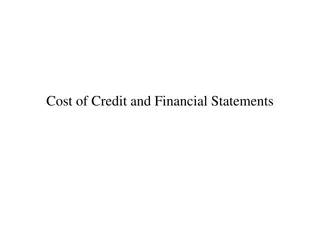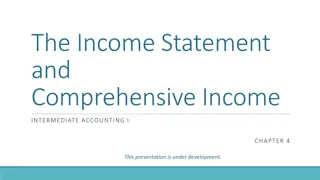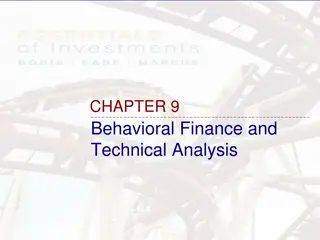Understanding Financial Statements Analysis in Business Finance
Understanding the analysis of financial statements is crucial for assessing the financial performance and position of an organization. This course provides knowledge, competencies, and skills necessary to apply basic financial statement analysis techniques, interpret financial numbers, and generate accounting and financial analyses. Learn to analyze financial and economic ideas for short and long-term business health, prepare management reports, and debate the implications of changing accounting policies on financial statements analysis.
- Financial statements analysis
- Business finance
- Financial performance
- Accounting ratios
- Decision making
Download Presentation

Please find below an Image/Link to download the presentation.
The content on the website is provided AS IS for your information and personal use only. It may not be sold, licensed, or shared on other websites without obtaining consent from the author. Download presentation by click this link. If you encounter any issues during the download, it is possible that the publisher has removed the file from their server.
E N D
Presentation Transcript
POSTGRADUATE DIPLOMA IN BUSINESS FINANCE AND STRATEGY Semester 1: Financial Statements Analysis [FSA] INTRODUCTION TO THE COURSE H V C Waduge ACA, BSc Mgt (Acc) sp, ICAEW Finalist (England & Wales)
OVERVIEW To understand the financial performance and financial position of a particular entity/organization properly, the financial statements analysis is must. Financial statements analysis is a mechanical process of undertaking in-depth observation/analysis of financial/non-financial information of the organization in order to ascertain the financial performance and position more accurately. This module aims to convey knowledge, competencies & skills relating to the application of basic financial statement analysis techniques. To analyze financial & economic ideas of business and health of business in short & long term aspects.
Knowledge Competencies Skills Understand the role of financial statements and analyze Use financial statements to generate both accounting and financial analysis Lead any management related discussion based on financial statements analysis data/information Understand the different accounting approaches produce different accounting and financial analysis Relate financial statements analysis competencies case scenarios Prepare suitable basic management reports using financial statements analysis skills Interpret financial numbers in financial analysis - - Explore economic reality embedded in financial reports - - Debate the implication of changing accounting policies for financial statements analysis - -
ANALYSIS OF FINANCIAL STATEMENTS What is analysis of financial statements? Basically a mechanism/method in which already reported financial numbers are reproduce in order to form opinions/better understand as to the entity spast and future performance and position(especially financial). How we could analyze financial statements? This task is typically associated with the calculation of accounting ratios. The calculation phase is a mechanical process with the real benefit of financial analysis being the interpretative stage. Why analysis of financial statements is need? The purpose of financial statement is to provide useful information to users/stakeholdersin their decision making, the financial data/information in these reports are expressed in monetary terms with corresponding figures for the comparative year(s).
ANALYSIS OF FINANCIAL STATEMENTS -Continued Further, information available in these reports mostlycater the general purpose. In order to better understand the consequences of an entity s operating, investing and financing position/situation, it is essential to analyze the relationships between the numbers in the financial reportsrather than relying on the absolute values appeared on the face of such reports. Who does need/require? Individuals/parties who are interested on entity s affairs/results and commonly called as stakeholders . These stakeholders broadly can be categorized as; external, internal and inter- related.(will be discussed in detail) How to conduct analysis of financial statements? Analysis of financial statements by using commonly acceptable accounting ratios is the most popular/common technique used in most circumstance while following techniques will also be used;
ANALYSIS OF FINANCIAL STATEMENTS -Continued Trend analysis Horizontal analysis Vertical analysis (will be discussed in detail) What is the basis? Main source/basis of conducting analysis of financial statements is general purpose financial statements (must be audited). Three phases of financial statements Mechanical/technical phase Analytical phase Decision making phase
FINANCIAL STATEMENTS What does refer financial statement? A pool of data/information prepared and presented by an entity (company) in a formal manner to meet the needs of various users/stakeholders who are not in a position to request/claim an entity to prepare financial reports tailored to their particular needs. (general purpose financial statements) Why an entity (company) prepares financial statements? Mandatory requirement (regulatory) Purpose of statutory income tax (statutory) Attract more investors (build confidence) Obtain financial facilities from institutions (banks) Obtain approval from various statutory bodies (TRC/BOI) & etc.
FINANCIAL STATEMENTS Use in the business Key aspects represents general purpose financial statements According to the accounting standards, financial statements should furnish adequate information about entity s; Financial position Financial performance Cash flows to a wide range of users in order to make their respective economic decisions. Hence, financial statements provide information about entity s; Net Assets position Overall debt position Working Capital and Gearing position Cash flow position Profit or Loss position Contribution of & distribution to owners
FINANCIAL STATEMENTS Key elements In order to provide information about financial performance, financial position and cash flows, a set of financial statements prepared by an entity should comprise with following key elements; Income Statement/Statement of comprehensive income Statement of financial position Statement of changes in equity Statement of cash flows Notes to the accounts including summary of accounting policies
FINANCIAL STATEMENTS Fundamentals Keys in compiling Financial Statements Keys are the basis/fundamentals which are compulsory being adherence in all circumstances. Following are the key fundamentals/sources; Accounting Principles (Non regulatory) (now need align with standards) Accounting Standards (Regulatory) Companies Act (Regulatory) CSE/SEC Rules (Regulatory)
ACCOUNTING PRINCIPLES Description Principle Fair Faithful presentation of the effects of transactions, other events and conditions in accordance with the determinants and recognition criteria for assets, liabilities, income & expenses set out in framework/LKASs. presentation Going concern Financial statements should prepare on a going concern basis unless management either intends liquidate the entity or to cease trading or has no realistic alternative but to do so. Accrual basis Income and expenses should recorded in the particular financial period irrespective whether they paid/received by cash provided those are relevant to such financial period. Offsetting An entity shall not offset assets and liabilities and/or income and expenses unless required or permitted by a standard. Frequency of reporting An entity shall prepare/present a complete set of financial statements (including comparatives) at least annually. Comparative information An entity shall disclose comparative information with respect to the previous period for all amounts reported in the current period s financial statements.
ACCOUNTING PRINCIPLES -Continued Consistency of presentation An entity shall retain the consistency of presentation and classification of items in the financial statements from one period to the next. Identification of financial statements An entity shall clearly identify the financial statements and distinguish them from other information in the same published document.
ACCOUNTING STANDARDS The Institute of Chartered Accountants of Sri Lanka (CA Sri Lanka), as a member of the International Accounting Standards Committee (IASC) is committed to development and enhancement of accounting standards. In working towards this mission, IASC develops and issues International Accounting Standards (IAS). IASC believes that the issue of such standards will help to improve the degree of uniformity of accounting throughout the world. As a condition of its membership of IASC, CA Sri Lanka is obliged to support the work of IASC, and specifically to incorporate IAS in Sri Lanka Accounting Standards (SLAS).CA Sri Lanka members are expected to comply with SLAS. Failure to do so may result in CA Sri Lanka inquiring into a member's conduct. It is impractical to establish accounting standards which universally apply to all situations and circumstances an accountant may encounter. Therefore accountants should consider SLAS as the basic principles which they should follow in performing their work.
ACCOUNTING STANDARDS -Continued The Sri Lanka Accounting and Auditing Standards Act, No. 15 of 1995 which authorizes CA Sri Lanka to issue SLAS, requires "specified business enterprises" to prepare and present their accounts in compliance with SLAS, with the object of presenting a true and fair view of their financial performance and condition, and requires their auditors to report whether such accounts are so prepared and presented and to specify clearly any deviations there from along with the reasons therefore. SLAS contain basic principles and essential procedures together with related guidance in the form of explanatory and other material. The basic principles and essential procedures are to be interpreted in the context of the explanatory and other material that provide guidance for their application. To understand and apply the basic principles and essential procedures together with the related guidance, it is necessary to consider the whole text of SLAS including explanatory and other material contained in SLAS, not just that text which is bold italic black lettered. SLAS need only be applied to material matters. (SLASs will be discussed in detail separately)
COMPANIES ACT NO. 07 OF 2007 Requirement/Responsibility Section 148 Duty to keep accounting records 149 Place where accounting records are kept 150 Obligations to prepare financial statement 151 Obligations to prepare financial statement 152 Obligations to prepare group financial statements 153 166 Contents and form of group financial statements Obligation to prepare annual report 167 Sending of annual report to shareholders 168 169 Contents of annual report Failure to send reports 170 171 Registration of financial statements Balance sheet date
CSE & SEC RULES/REGULATIONS The Securities and Exchange Commission of Sri Lanka (SEC) was established in pursuance of the Securities and Exchange Commission of Sri Lanka Act, No. 36 of 1987 as amended by Act No. 26 of 1991, Act No. 18 of 2003 and Act no. 47 of 2009. Vision: To become the benchmark regulator in South Asia for effective, efficient and proactive capital market regulation Mission: "To promote, develop and maintain a capital market that is fair, efficient, orderly and transparent
CSE & SEC RULES/REGULATIONS -Continued Main Objectives: The creation and maintenance of a market in which securities can be issued and traded in an orderly and fair manner. The protection of the interest of investors. The operation of a Compensation Fund to protect investors from financial loss arising as a result of any licensed stock broker or licensed stock dealer being found incapable of meeting his contractual obligations. The regulation of the securities market and to ensure that professional standards are maintained in such market.
Time for questions























